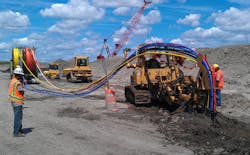New AASHTO HDPE Conduit Standard Now Available
A new standard, "Standard Practice for Solid Wall High-Density Polyethylene Conduit for Non-Pressure Applications Used for the Protection of Power and Telecommunications Cables," was recently published by the American Association of State Highway and Transportation Officials (AASHTO).
Known as AASHTO "Standard Practice R 63," it provides guidance in the specification of high-density polyethylene (HDPE) conduit used in buried applications for the protection of power and communications cables as well as covers material, dimensional, workmanship, and performance requirements. Communication applications include intelligent highway systems (ITS), closed circuit TV (CCTV), and fiber-optic cables along highway rights of way. Supervisory control and data acquisition (SCADA) applications include pipeline control, positive train control technology, and traffic control and monitoring. Highway and airport lighting, electrical distribution, and transmission lines are some of the power applications.
According to an update recently released by the Plastics Pipe Institute Inc. (PPI), the AASHTO document explains that HDPE conduit is a protective pathway for telecommunications and power cables used throughout the infrastructure. The inherent properties of HDPE, such as chemical resistance and stress crack resistance, are well-suited for infrastructure systems since these require long service life. Because of HDPE coilable conduit's long lengths, flexibility, and tensile strength, it is ideally suited for HDD and plowing installation methodologies that have minimal impact on traffic and the surrounding infrastructure. HDPE conduit is also available in 20- to 40-ft length "sticks" in larger diameters above 6 in. for installations requiring multiple pathways (innerducts) to run through one service pathway.
The standard also identifies typical installation methods that include trenching, plowing and horizontal directional drilling (HDD). For more detailed design information, visit the PPI website.

